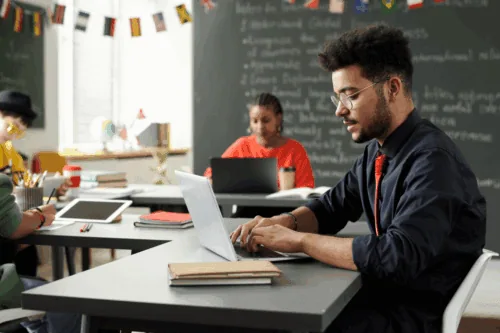Welcome to the dynamic world of blended learning, a modern educational approach that combines traditional classroom techniques with the flexibility and innovation of online learning. This guide is crafted to help entry-level job seekers, educators, and all learners understand the essence, benefits, and practical applications of blended learning.
Why Blended Learning?
As the educational landscape evolves, blended learning emerges as a critical strategy to cater to diverse learning needs, enhance engagement, and provide students with the necessary tools to succeed academically and professionally. This guide will take you through the core aspects of blended learning, showcasing why it’s beneficial and how it can be implemented effectively.
Whether you’re exploring educational options, seeking to upgrade your skills, or looking for a comprehensive educational framework, this guide offers valuable insights into making the most of blended learning. Let’s dive into how this approach can transform traditional education and create inclusive, adaptable, and engaging learning experiences.
What is Blended Learning?
Blended learning is a dynamic educational approach that combines traditional classroom methods with digital media and online educational techniques. This method leverages both face-to-face interaction and online engagement to facilitate a more versatile and comprehensive learning experience. Here’s what makes blended learning stand out:
Integrated Learning Environments
At its core, blended learning merges online educational resources with traditional in-person classes. This means students can watch video lectures, participate in virtual discussions, and access readings online, alongside attending scheduled classes led by educators. This integration provides flexibility and caters to different learning styles and paces.
Customizable Learning Paths
Blended learning allows for personalized education, where students can tailor their learning journeys to fit their specific needs and goals. For instance, they can delve deeper into interesting areas or spend more time on challenging topics. This aspect of blended learning underscores its adaptability, which is essential for inclusive education, as discussed in Opportunities for Inclusion.
Use of Advanced Technology
Schools and institutions employ advanced technological tools to support blended learning. These include Learning Management Systems (LMS), interactive apps, and AI-driven platforms facilitating real-time feedback and collaborative projects. This tech-forward approach enhances learning and prepares students for a digital world.
Global Learning Opportunities
Blended learning can connect students worldwide through online components, enabling cross-cultural interactions and exposure to diverse perspectives. Platforms like the U.S. Department of Education’s Office of Educational Technology provide policies and tools that support such global engagement.
Blended learning’s versatility and adaptability make it a powerful model for today’s educational demands. By combining the best of both worlds, it creates engaging and effective learning experiences that are both inclusive and expansive.
Benefits of Blended Learning
Blended learning goes beyond traditional education models by offering distinct advantages that cater to diverse learning needs. Here’s how it makes a difference:
Enhanced Engagement and Motivation
Combining interactive online content with face-to-face teaching keeps students engaged. Tools such as gamified learning and video tutorials can help maintain student interest and motivation, making the educational process more enjoyable and effective.
Increased Accessibility
A key advantage of blended learning is its ability to make education more accessible to everyone. Students who might not be able to attend in person due to geographic, financial, or physical constraints can participate online. This inclusivity is crucial for building diverse learning environments, which are detailed further in Effective Resume Writing.
Personalized Pace and Feedback
Blended learning allows students to progress at their own pace. Those who need more time can review materials as needed, while others can advance more quickly if they grasp concepts faster. Online assessments provide immediate feedback, helping learners identify areas needing improvement promptly.
Skills Development for Modern Workplaces
By integrating technology into the learning process, blended learning helps students develop digital skills that are increasingly important in the modern workforce. Skills like digital communication, online research, and data analysis prepare students for future careers, aligning with the advice found at Handling Job Offers.
Cost-Effectiveness
Schools and educational institutions can reduce costs by using blended learning models. Digital materials often cost less than traditional textbooks and don’t require physical storage. Additionally, the capacity to host many students online can lead to decreased infrastructure expenses.
Resource Efficiency
Blended learning promotes the efficient use of teaching resources. Educators can easily reuse and update digital materials, ensuring that content remains current and relevant without the constant need for new physical materials. This efficiency supports a more sustainable approach to education.
Overall, the benefits of blended learning contribute to more dynamic, inclusive, and effective educational experiences. By leveraging technology alongside traditional methods, it offers a robust solution to the challenges of modern education.
Key Components of an Effective Blended Learning Strategy
Certain foundational elements must be present to ensure a successful blended learning program. Here’s what shapes an effective strategy:
Clearly Defined Objectives
Firstly, setting clear learning goals is critical. These should align with student needs and course outcomes. This clarity helps design the right blend of in-person and online activities.
Reliable Technology Infrastructure
Accessibility to robust technology is crucial. Schools need high-speed internet and supportive digital tools that all students can access. Reliable tech ensures the smooth implementation of blended learning.
Engaging and Interactive Content
Content needs to capture attention. Incorporate multimedia elements such as videos, interactive simulations, and quizzes. These elements make learning enjoyable and help retain student interest.
Continuous Support and Training
Support for both students and teachers is essential. Provide ongoing training for educators to manage tech tools effectively. Similarly, it offers technical support to students to overcome challenges swiftly.
Robust Assessment Methods
Frequent assessments are vital for measuring learning progress. To accommodate diverse intelligence types, use a variety of methods, such as quizzes, peer assessments, and project-based evaluations.
Data-Driven Decision Making
Use data to guide adjustments and improvements. Monitor student performances and engagement levels to tweak the program as needed. This responsive approach helps optimize learning outcomes.
This strategic framework supports effective blended learning and prepares educational institutions to adapt to future changes in teaching and learning dynamics.
Blended Learning in Action: Case Studies
Exploring real-world examples can illuminate the practical benefits and applications of blended learning. Here are a few case studies that showcase its effectiveness in various educational settings:
Public High Schools in California
A public high school implemented blended learning to cater to diverse student needs. Through a combination of online modules and traditional classroom teaching, students improved their test scores by 15% within one academic year. This approach also allowed for personalized tutoring sessions, further enhancing student learning outcomes.
Community College Network
A group of community colleges used blended learning to expand their course offerings. Students could access specialized courses not available at their home campuses. This not only maximized resource usage but also facilitated inter-collegiate collaboration.
Corporate Training Program
A global corporation introduced a blended learning program for its employees worldwide. The program featured online leadership training modules combined with in-person workshops.
International Language School
An English language school for non-native speakers adopted a blended learning model to provide flexible learning options. Students engaged in interactive online language exercises at home and attended conversational in-person classes, resulting in improved language skills and better cultural integration.
Challenges and Solutions in Blended Learning
While blended learning offers significant advantages, it also presents unique challenges that require strategic solutions. Understanding these issues can help educators optimize their blended learning environments.
Challenge: Student Engagement
Keeping students engaged with online materials can be challenging. Interactive content and regular, real-time interactions can keep students interested and active. Additionally, integrating tools from educational sites can enrich the experience.
Challenge: Training for Educators
Teachers may struggle with the digital aspects of blended learning. Offering ongoing professional development is crucial. Schools can create workshops or provide access to online courses focusing on digital education skills.
Challenge: Consistency and Quality Control
Ensuring the quality and consistency of learning materials across digital and traditional platforms is essential. Using established educational standards and regular review processes can help maintain high-quality content.
Solution: Leveraging Data
Analytics can be used to track participation and understanding, influencing course adjustments. This data-driven approach ensures that learning objectives are met more effectively.
While these challenges may seem daunting, practical solutions exist that can overcome barriers and enhance the effectiveness of blended learning programs. By addressing these issues head-on, institutions can provide more equitable and engaging learning experiences. Interview Questions and panel discussions might further explore these themes, enhancing educators’ preparedness and resourcefulness.
The Future of Blended Learning in Education
Blended learning is not just a passing trend in education; it’s a robust approach likely to shape the future of educational services. As technology continues to evolve, so too will the methods and effectiveness of this type of learning.
Innovations in AI and Learning Analytics
Advancements in artificial intelligence and analytics will personalize learning experiences further, allowing for adaptations to individual student needs in real time. This technology will enable educators to identify gaps in knowledge promptly and tailor content accordingly.
Greater Integration with Virtual and Augmented Reality
Virtual Reality (VR) and Augmented Reality (AR) technologies are set to become more prevalent in blended learning environments. They offer immersive experiences that can enhance understanding and engagement in complex subjects.
Increased Emphasis on Social Learning
Blended learning will continue to promote collaborative projects and peer-to-peer learning opportunities. This will enhance learning outcomes and build essential social skills in a digital age.
Wider Access and Global Reach
As technology accessibility improves, blended learning could reach a global audience, breaking geographical barriers to education and offering quality learning opportunities worldwide. Entities like UNESCO emphasize the importance of inclusive and equitable quality education and promote lifelong learning opportunities for all.
These advancements will help prepare students not only for the jobs of the future but for a lifelong journey of learning and personal development.
How to Choose the Right Blended Learning Tools
Selecting the appropriate tools is crucial for the success of a blended learning program. The right technology can enhance learning efficiency and engagement. Here’s how to make the best choices:
Identify Learning Needs and Goals
Understand your student’s specific needs and curriculum goals. This understanding will guide you in choosing tools that align well with your educational objectives.
Evaluate User-Friendliness
Select tools that are easy to use both for instructors and students. User-friendly interfaces reduce onboarding time and minimize frustration, fostering a more positive learning experience.
Consider Compatibility and Integration
The tools should easily integrate with existing systems and be compatible across various devices to ensure accessibility. This seamless integration supports a smooth and continuous learning process.
Assess Scalability and Support
Choose tools that can grow with your educational needs. It’s also important that they come with reliable technical support to handle any issues that arise.
Review Security and Privacy Protections
It’s essential to select tools that protect the privacy and security of student data and ensure that they comply with relevant laws and regulations, such as those advised by FERPA regulations.
FAQs
Some common questions about blended learning are answered to clarify doubts and expand understanding.
What is the ideal ratio of online to in-person learning?
There’s no one-size-fits-all ratio. It varies based on course objectives, student needs, and resources. However, a balanced approach is often most effective.
Can blended learning be as effective as traditional learning?
Yes, when implemented correctly, blended learning can be equally or more effective. It combines the best aspects of both in-person and online learning.
How can educators ensure students remain motivated in an online setting?
Engagement is key. Use interactive content, timely feedback, and personal interaction to keep students motivated and involved.
What are some challenges teachers face with blended learning?
Adjusting to technology, managing online and offline tasks simultaneously, and personalizing learning paths can be challenging. Training and support help overcome these.
Are there specific subjects that benefit more from blended learning?
Blended learning is versatile but particularly beneficial in subjects requiring hands-on practice or interactive learning, like sciences, languages, and technology.
Conclusion
Blended learning is a transformative approach that combines traditional face-to-face instruction with digital technology. It provides flexibility, personalized learning opportunities, and access to a wealth of online resources. By integrating various educational tools and strategies, blended learning meets diverse educational needs and prepares students for the challenges of the modern world.
Embrace the Future of Education
As education continues to evolve, embracing blended learning can benefit educators and learners significantly. It caters to different learning styles, enhances student engagement, and promotes the development of digital skills critical for future success.
If you want to enhance your educational strategies or find opportunities with inclusive, forward-thinking organizations, consider joining Diversity Employment. Explore a platform where diverse opportunities meet innovative educational practices, contributing to a richer, more inclusive diversity job search and future.




